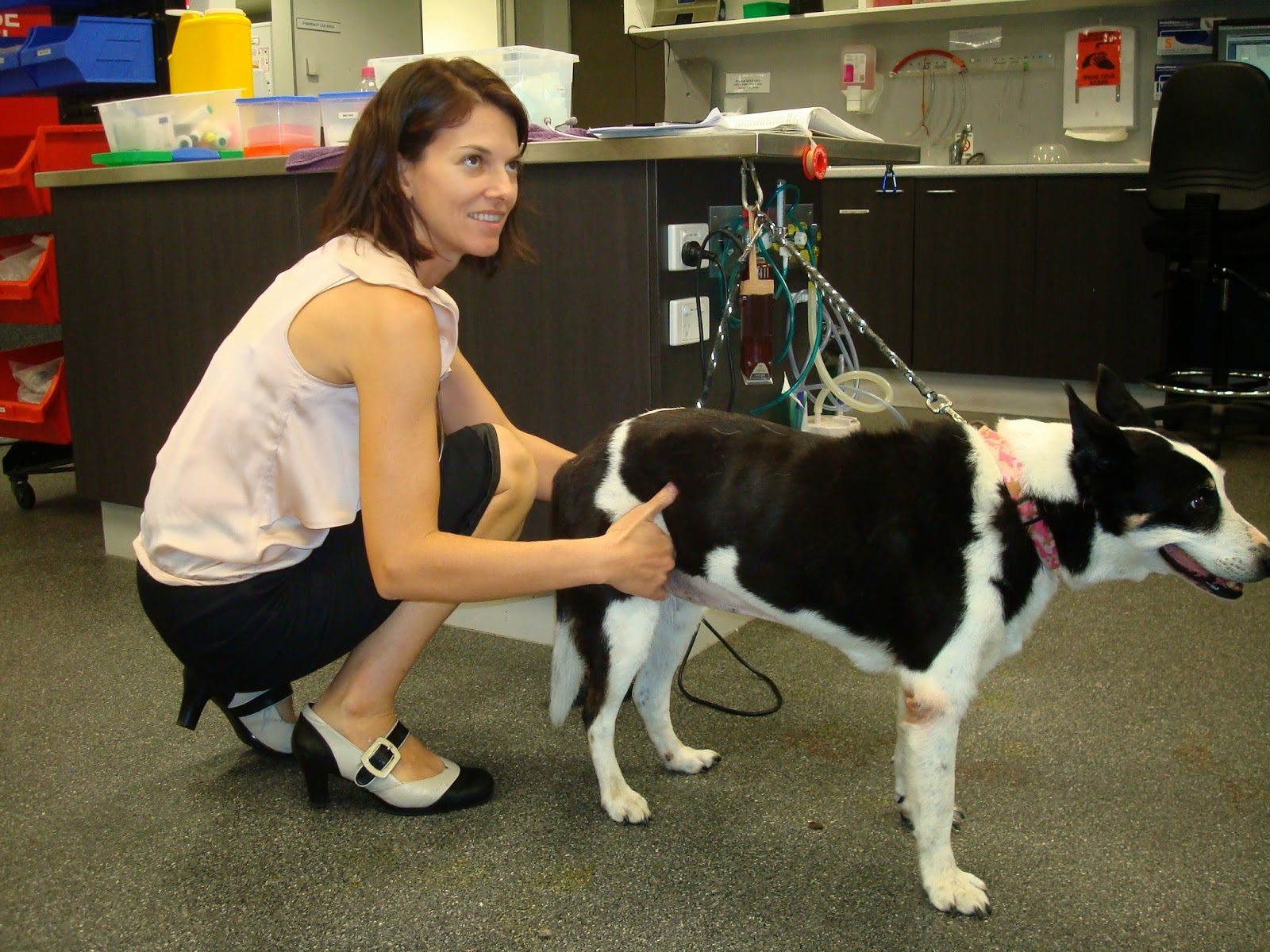 |
| Associate Professor Fiona Campbell examines a dog (yes, she's a cardiologist and she's focusing on the back end. Why? I think she's assessing the femoral pulse here). |
Professor Lynelle Johnson and Associate
Professor Fiona Campbell are friends and colleagues – they’re also veterinary
specialists (internal medicine and cardiology respectively) who are teaming up
to deliver a two day program on cardiorespiratory medicine later this month.
Despite the fact that the
cardiovascular system and respiratory system are two different systems, working
out which is causing the signs in a particular patient isn’t easy. The signs
can be the same (cough, increased respiratory rate, respiratory distress).
Abnormal breathing and lung sounds can be seen in animals with heart disease,
respiratory disease or both. Radiographs don’t always helps – a huge heart
(cardiomegaly) can mask signs in the respiratory system, and fluid on the lungs
can mask the underlying cause.
You can throw a lot of advanced
diagnostics (echocardiography, CT, fluoroscopy, etc) at the problem without
getting the answer – so decision making is really vital. And the stakes are
high. Animals with cardiovascular or respiratory disease can crash rapidly. So
I was interested to find out about the respective career paths of Drs Johnson
and Campbell, both of whom are delivering a weekend workshop on this very issue
in Brisbane this month (May 15 and 16).
What’s your day job and how did you get there?
Dr Johnson: I am currently a professor at the University of California, Davis School of Veterinary Medicine. I graduated from The Ohio State College of Veterinary Medicine, worked in private practice, did a residency and Masters degree in internal medicine at the University of Illinois, was a did cardiopulmonary research at Colorado State University, completed a PhD in Physiology at the University of Missouri, and joined the faculty of UCD in 2000. It was here that I met Fiona when she came to do a cardiology residency in 2003. We worked together closely during that time and she has remained a valuable source in cardiology, as well as a close friend.
 |
| Professor Lynelle Johnson with a patient. |
Dr Campbell: I spend most of my time
seeing patients referred with suspected heart disease at Veterinary Specialist
Services, a large referral hospital in SE QLD where I work 3-4 days per week. I
also have a fractional appointment at the University of Queensland (UQ) where I
enjoy lecturing undergraduate veterinary students and veterinary technician
students and seeing referred cardiac patients with them during their clinical
years.
I graduated from UQ Veterinary Science
in 1996, then worked in small animal practice in the United Kingdom, James
Herriot style for a few years before returning to Australia. I was always
fascinated by cardiology; the role of the heart in sustaining life always
seemed so tangible to me, unlike the abdominal viscera which just seemed like
theoretical necessities!
So in pursuit of all things cardiac, I
completed my cardiovascular physiology PhD at UQ in the veterinary and
biomedical science schools in 2001. Then in 2003, I was fortunate to be
accepted into the cardiology residency program at the University of California,
Davis. Since 2007, I have been back in Australia and have divided my time
between academia and speciality practice. Being involved with veterinary
teaching at UQ is a buzz for me; not only do I find the students enthusiasm
infectious, but there is also something special about that continued involved
with my alma mater. But my real joy is a busy day in specialty practice where I
am able to pursue my passion for helping pets with heart disease.
What tend to be the most challenging cardiorespiratory cases
seen in practice?
Dr Johnson: In my opinion, the most challenging cases are those that have signs of both cardiac and respiratory disease and the doctor has to figure out which disease is causing cough or respiratory difficulty. Sometimes, despite all the specialists and sophisticated diagnostics available, the answer to the case remains obscure.
Dr Campbell: Certainly distinguishing
cardiac from respiratory patients can be very challenging; for general
practitioners and specialists alike! But as a result of this weekend program I think
that most delegates will feel much better equipped to managed these cases with
competence.
Do you have a couple of useful tips you might share with
vets that would make their approach to these cases a little easier?
Dr Johnson: Fiona and I are going to
spend 2 hours specifically on this question. Early lectures will build on
physical exam findings, localizing disease, efficient diagnostic testing, and
managing common problems, then the final 2 hours are cases that have challenged
us. The audience will work through the cases with us and decide if they think
we have to the right conclusion! As veterinarians, we are blessed with an
education that focuses on history anda thorough patient examination, and those are the most important things (in my
opinion) in solving the puzzle.
If you want to learn more from this
team, or read more about the project they’ve put together, click here.
